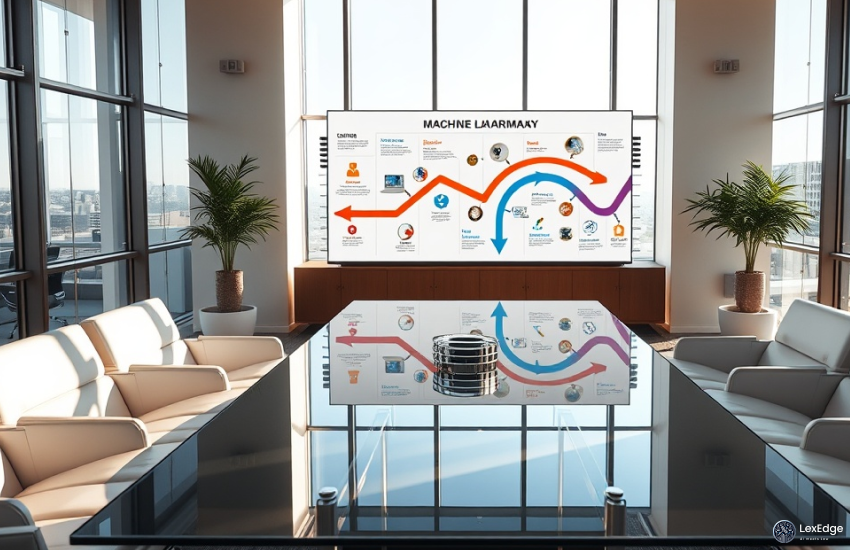Machine Learning for Case Outcome Prediction: Transforming Legal Decision-Making

Machine learning is reshaping the legal landscape by enabling highly accurate case outcome predictions through advanced algorithms, NLP techniques, and judicial behavior modeling. With accuracy rates surpassing traditional methods, ML supports early case assessment, settlement strategy, and litigation planning. Despite challenges like bias and evolving laws, emerging trends such as transformer-based models and continuous learning signal a powerful future for AI in case prediction.
The Origin Story From Intuition to Algorithms

Historically, predicting case outcomes relied heavily on the expertise of lawyers who interpreted prior rulings, judge tendencies, and specific factual nuances. While this traditional method held value, it was limited by human cognitive biases and the overwhelming volume of legal data. The emergence of predictive analytics and machine learning (ML) in the early 21st century transformed this landscape, enabling the analysis of millions of cases, court documents, and legal patterns at unprecedented scale and speed.
Modern platforms like Lex Machina and NeXa AI now utilize vast datasets built over decades of federal case law to train highly advanced algorithms. These systems deliver superior accuracy in case outcome prediction by evolving from basic statistical models to more advanced architectures, such as Random Forest, neural networks, and other AI-driven legal analytics tools. This continuous evolution significantly enhances predictive performance and empowers legal teams with data-driven decision-making capabilities.
Core Ideas and Supporting Data

- Historical Pattern Analysis : ML models analyze historical legal data to identify trends based on case type, jurisdiction, judge assignment, and counsel characteristics, improving case outcome prediction accuracy.
- Judicial Behavior Modeling : Algorithms learn judge decision patterns, enabling more precise predictions for specific courts and enhancing judicial analytics for legal teams.
- Contextual Variable Integration : Advanced ML systems integrate economic conditions, legal precedent changes, and other contextual factors, strengthening predictive analytics in law.
Textual Data Processing (NLP) : Using natural language processing (NLP), machine learning can interpret legal documents, contracts, motions, and case filings, transforming them into structured insights for legal prediction models.
Accuracy Benchmarks

- Contract Disputes – ML achieves 85–92% accuracy, making it a powerful tool for contract case forecasting.
- Patent Litigation – Models deliver 78–85% accuracy, enhancing IP law predictive analytics.
- Employment Cases – ML reaches 82–88% accuracy, improving employment law outcome prediction.
- Commercial Litigation – Accuracy ranges between 80–87%, supporting better business dispute forecasting.
Overall, these machine learning prediction rates significantly outperform traditional lawyer predictions, which typically fall between 60–75%—highlighting the growing value of AI-driven legal decision-making.
Real-World Applications and Anecdotes

- Early Case Assessment – ML provides predictive insights from the start of a case, helping legal teams shape strategy and optimize resource allocation.
- Settlement Strategy Optimization – Machine learning predicts settlement probabilities, enabling data-driven and more confident negotiations.
- AI-Powered Case Management – ML tools help law firms prioritize cases, monitor progress, and enhance efficiency throughout the litigation lifecycle.
- Judicial Analytics – Advanced models analyze judge behavior, supporting more tailored legal arguments and strategic planning.
A leading litigation management company used dual machine learning models to strengthen case management, resulting in smarter decision-making and improved client outcomes.
Challenges, Limitations, and Critical Viewpoints

- Unique Case Complexity – Every legal case has distinct facts and variables, making it difficult for ML models to generalize predictions with complete accuracy.
- Evolving Laws & Regulations – Frequent updates to legal statutes can reduce the relevance of historical data, impacting the reliability of machine learning predictions.
- Bias & Fairness Issues – ML models may unintentionally reinforce biases present in training data, leading to fairness and ethical concerns in legal decision-making.
- Interpretability Challenges – Complex algorithms, especially neural networks, often function as “black boxes,” making it hard for legal professionals to understand or justify predictions in sensitive cases.
Emerging Trends and Future Possibilities

- Transformer-Based Models: Large language models (e.g., GPT-4) are increasingly effective for predictive tasks.
- Precedent Identification: New methods improve relevance detection in case law.
- Continuous Learning: Data pipelines enable models to adapt to ongoing legal changes.
- Data-Centric AI: Emphasis on data quality enhances prediction reliability.
Conclusion
Machine learning is redefining legal strategy by offering precise, data-backed case outcome predictions that outperform traditional intuition-based methods. As legal professionals adopt these tools, they gain significant advantages in case assessment, negotiation, and judicial analysis. While awareness of bias and interpretability remains crucial, AI-driven decision-making is becoming essential for firms seeking efficiency, accuracy, and competitive edge in a rapidly evolving legal environment.

